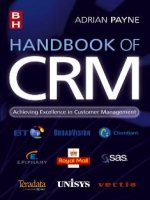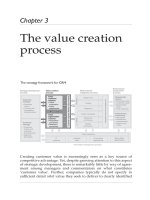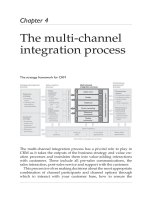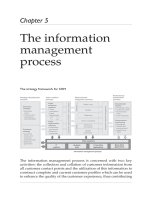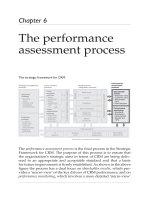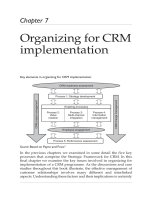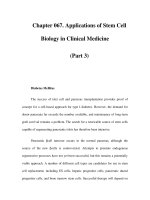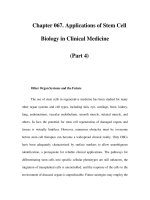HANDBOOK OF CRM: Achieving Excellence in Customer Management Part 7 pot
Bạn đang xem bản rút gọn của tài liệu. Xem và tải ngay bản đầy đủ của tài liệu tại đây (1015.47 KB, 111 trang )
Chapter 7
Organizing for CRM
implementation
Process 1: Strategy development
Enabling processes
Process 4:
Information
management
Process 3:
Multi-channel
integration
Process 2:
Value
creation
CRM change management
CRM project management
Process 5: Performance assessment
CRM readiness assessment
Employee engagement
Key elements in organizing for CRM implementation
In the previous chapters we examined in some detail the five key
processes that comprise the Strategic Framework for CRM. In this
final chapter we examine the key issues involved in organizing for
implementation of a CRM programme. As the discussions and case
studies throughout this book illustrate, the effective management of
customer relationships involves many different and interlinked
aspects. Understanding these factors and their implications is certainly
Source: Based on Payne and Frow
1
HCRM-Ch07.qxd 9/16/05 10:59 Page 328
critical to the success of any CRM initiative. However, simply think-
ing through the processes of CRM is not enough to ensure it is devel-
oped and implemented appropriately. Firms have to organize to
deliver results from their CRM programmes.
The figure above sets the five key CRM processes addressed in the
preceding chapters in the context of organizing for CRM implemen-
tation. Here they are positioned relative to four critical elements of a
successful CRM programme: CRM readiness assessment; CRM
change management; CRM project management; and employee
engagement. This figure is an organizing model that represents the
broad stages of progression. However, the model is recursive rather
than linear in that its many activities need to be managed concur-
rently and some elements will need to be revisited as a conseq-
uence of later activities. Organizing for CRM involves systematically
and interactively addressing each of these four elements as they
relate to the five key CRM processes.
1
Before a CRM strategy is developed, it is important to assess
whether the organization is really ready and willing to implement
customer-focused strategies and CRM initiatives. CRM is not an
appropriate strategy for a company to adopt if it does not have
the leadership of the enterprise engaged in supporting CRM and a
board-level sponsor committed to its success. Thus, the cultural
and leadership implications of CRM implementation must be fully
understood if it is to have any chance of contributing to business
improvement.
At the beginning of the book the essence of CRM was captured in the
statement: ‘CRM is information-enabled relationship marketing’. This
concise description can be seen to hold much greater meaning now that
we have examined many of the complexities and requirements of effec-
tive customer relationship management. CRM is indeed about leverag-
ing relationships for mutual benefit through the skilful utilization of
customer knowledge. But it is also about building stronger and more
productive relationships with other stakeholders, particularly employ-
ees. This is evident in the fact that the main source of competitive
advantage today is customer intimacy (discussed in Chapter 2)
achieved through excellent customer service. Here employees have a
critical role to play in its delivery.
We now consider how the elements of CRM readiness assessment,
CRM change management, CRM project management and employee
engagement come together to support the organization and implemen-
tation of a CRM strategy. We start by considering the CRM readiness
Organizing for CRM implementation 329
HCRM-Ch07.qxd 9/16/05 10:59 Page 329
assessment which helps the CRM sponsors and leaders assess the
overall position in terms of readiness to progress with CRM initiatives
and to identify how well developed their organization is relative to
other companies.
CRM readiness assessment
In undertaking an assessment of CRM readiness we propose two tasks
should be undertaken. First, an assessment should be made of overall
CRM maturity relative to other companies that have embarked on the
CRM journey and barriers to CRM success should be identified. This
will provide a more general perspective to the company’s current situ-
ation and help them benchmark where they are relative to other
organizations. This is important as it provides the opportunity to
assess relative competitive advantage. Second, a CRM readiness audit
will help determine both how advanced your company is in its overall
readiness to adopt or further develop CRM, and in which of the five
processes in the CRM strategy framework your organization needs to
place greatest emphasis. This audit will help the enterprise identify
the key areas of importance in terms of CRM performance. Thus, a
decision to adopt or enhance an enterprise’s CRM activities should be
based on understanding:
● its current stage of development and potential barriers to success
● its overall readiness to adopt CRM and
● the CRM activities that need to be addressed.
An assessment of these three elements through a CRM maturity
assessment and a CRM readiness audit will assist the organization in
deciding how to organize its CRM activities.
CRM maturity assessment
The emphasis an organization places on using data to help design
and implement CRM strategies is reflected in the organization’s
stage of CRM development. In Chapter 2 we discussed how each
organization should adopt a level of sophistication in CRM strategy
appropriate to their competitive environment and their needs now
and in the future. We identified four broad strategic options facing
330 Handbook of CRM: Achieving Excellence in Customer Management
HCRM-Ch07.qxd 9/16/05 10:59 Page 330
organizations – product-based selling, customer-based marketing,
managed service and support and ‘individualized’ CRM; the latter
requiring collection and analysis of extensive information about cus-
tomers and the desire and ability to give customers highly individu-
alized service. These options, considered as part of the strategy
development process, now need to be considered in a much broader
context of overall CRM implementation requirements. In particular,
the degree of CRM development in other organizations provides a
useful context for an enterprise to consider its own CRM initiatives.
Our research has shown that there are identifiable stages of matur-
ity in CRM development. Each stage represents a level of CRM
maturity characterized by the extent to which customer information
is used to enhance the customer experience and customer-generated
cash flows. However, each stage encompasses issues beyond choice
of strategic options. More often than not CRM development requires
wide-ranging adjustments within the firm, especially where market-
ing needs to shift from a product or transactional focus to a customer
relationship focus. The kinds of organizational changes needed to
embrace CRM can range from a revolution in mindset to a realign-
ment of systems and processes. Special change management, project
management and customer engagement activities are usually neces-
sary to minimize disruption and risk and maximize performance.
Strategies that do not take these dimensions on board are unlikely to
succeed with their implementation of CRM.
To identify experiences and use of CRM the author and his col-
league Lynette Ryals of Cranfield University undertook a study to
investigate the development of CRM in organizations.
2
As our
research showed that CRM is typically more advanced in the retail
financial services sector than in other industry sectors, we focused
on this sector in order to examine the stages of CRM development.
Five levels of maturity in the development of CRM were identified:
1. Pre-CRM planning
2. Building a data repository
3. Moderately developed CRM
4. Well developed CRM
5. Highly advanced CRM.
Stage 1: Pre-CRM planning
The first stage is planning for the introduction CRM. This is the point
at which organizations recognize the importance of CRM, however,
Organizing for CRM implementation 331
HCRM-Ch07.qxd 9/16/05 10:59 Page 331
they have not yet progressed to a stage where the CRM project has
been fully scoped. Organizations at this stage should particularly con-
sider the implications for their organization of the four broad strategic
options discussed earlier: product-based selling, customer-based mar-
keting, managed service and support and ‘individualized’ CRM.
Companies planning to introduce CRM especially need to undertake a
CRM readiness audit – the structure of which is outlined shortly.
Stage 2: Building a data repository
The second stage of CRM is concerned with building an appropriate
data repository – often in the form of a data warehouse. As covered ear-
lier in Chapter 5, construction of the main data repository includes col-
lecting and reviewing existing data and cleaning and de-duplicating
customer records.
If the data repository is to be used predominantly for analytical
CRM a data warehouse needs to be built to support the required ana-
lytical tasks. If the data repository is to be used primarily to support
operational CRM then an operational data store (ODS) is required.
This was also discussed in Chapter 5. Where companies need to
address analytical and operational CRM, it is likely both forms of
data warehouse may be required. Plans for the organization’s data
infrastructure are based on the data warehouse. Pilot data ware-
houses, an ODS or smaller data marts may be built as a preliminary
step, prior to full implementation.
The key task associated with building a data warehouse is cus-
tomer identification and data capture. Because of the data quality
issues that emerge as companies begin to collect and centralize their
customer data, organizations in the early stages of CRM develop-
ment find they have to focus heavily on identifying who their cus-
tomers are. We have found multiple records for a single customer and
missing or out-of-date addresses are common problems. Managers
find gaps, ambiguities and omissions in data they previously had
assumed were complete and accurate. Often, enormous amounts of
effort have to be expended in compiling accurate customer informa-
tion. This typically involves collecting information from many sepa-
rate databases and legacy systems.
Data integrity needs to be checked carefully. In one bank, a manager
described how his organization was proud of the fact it had date of
birth information for most of its customers. However, when the bank
reviewed this information it found out that 10 per cent of the customer
base appeared to have been born on 11
th
November 1911, or 11/11/11.
332 Handbook of CRM: Achieving Excellence in Customer Management
HCRM-Ch07.qxd 9/16/05 10:59 Page 332
It was later discovered that some of the bank’s data entry operators
were too embarrassed to ask certain customers their date of birth and,
pressured to fill the required data field, they found they could enter
any number and the system would accept it. A series of ‘1’s was
the most popular choice. Such data integrity problems may require
considerable efforts to rectify.
Stage 3: Moderately developed CRM
Organizations which are moderately developed in CRM are those
which have typically progressed to a full data warehouse, although it
may still be limited to a single business unit rather than being enter-
prise-wide. They begin to use tools such as sales force automation,
call centres and computer telephony integration and campaign man-
agement in a more sophisticated manner but still on a ‘stand alone’
basis. At this stage, the CRM focus shifts towards data mining and
identifying the value that can be extracted from the organization’s
existing customer information.
Having gathered and cleaned their data, these organizations turn
their attention to the task of customer profitability analysis and seg-
mentation and recognize the need to identify their most profitable
customers, to profile them and to find more customers like them.
However, few companies at this stage are able to generate fully satis-
factory customer profitability analyses. In some cases initial customer
profitability analyses were seen to challenge received wisdom. For
example, one bank found that the most profitable 10 per cent and the
least profitable 10 per cent of its customers had purchased almost
identical numbers of the bank’s products. Clearly, for this bank, their
existing strategy of ‘sell more products, make more money’, was not
always correct.
Some organizations at this stage change their approach to segmen-
tation as a result of the development of their data warehouse.
Previously, segmentation was viewed by them as a way to divide up
the total customer base into more or less homogeneous groups.
However, it was then difficult to determine which individual cus-
tomers went into which segment. After the data warehouse became
operational, managers were better able to identify their most prof-
itable customers. They could then profile these individuals and focus
efforts on acquiring more customers like them. In such cases, the seg-
mentation approach shifted from one using a set of general customer
characteristics to one incorporating the level of customer profitability
or customer value.
Organizing for CRM implementation 333
HCRM-Ch07.qxd 9/16/05 10:59 Page 333
Stage 4: Well developed CRM
‘Well developed’ suggests an organization that is moving towards an
enterprise-wide data warehouse, widening its user base and increas-
ing the number of users and further developing front-office tools
such as sales force automation and contact centres. Such organiza-
tions will be more advanced in e-commerce applications. At this
point, external proprietary data sources, such as Mosaic and GIS, are
routinely fed into the data warehouse to enhance the company’s own
information.
A key task at this stage is customer prioritization. Gaining a deeper
understanding of profitable customers becomes an important part of
CRM activities. Use of increasingly sophisticated segmentation and
profiling to do this becomes common. Customer prioritization also
leads to strategies for reducing the cost of serving less profitable cus-
tomers, such as encouraging customers to switch from using a counter
service to using the telephone or Internet. Typically, the segmentation
exercise also identifies undesirable customer groups.
Organizations in this group utilize much more effective campaign
management by fully exploiting their data warehouses. One insur-
ance company at this stage of development contrasted their current
highly targeted approach with their previous practice of mailing one-
twelfth of their database each month, irrespective of whether the
products they were prioritizing were relevant to the customers they
were mailing.
Stage 5: Highly advanced CRM
Organizations that have reached the highly advanced or ‘best in
class’ status are fully integrated, offering extensive data warehouse
access within the company across departmental functions. They may
use advanced techniques such as neural networks and genetic algo-
rithms to generate more refined data and continually learn from their
customer information. They are highly advanced in terms of their
market segmentation strategies and understanding of the required
level of segment granularity. They routinely use predictive model-
ling. Because these organizations typically have a wide user base
using their data warehouse, they also employ data visualization tools
to present data in an easier-to-use chart format. Relatively few organ-
izations have reached this level of CRM sophistication. American
Express, USAA – the US insurance company, and MBNA America –
the credit card company, are examples of companies that have
reached this stage.
334 Handbook of CRM: Achieving Excellence in Customer Management
HCRM-Ch07.qxd 9/16/05 10:59 Page 334
A task associated with such advanced usage of CRM is more
active customer management in which organizations use tools such
as campaign management to engage in an ongoing dialogue with a
customer and to reap the maximum profit potential throughout the
customer’s lifetime. Such organizations with more developed CRM
integrate a clearer understanding of the value of the customer with
active customer management.
Reviewing your stage of CRM maturity
Organizations should use these guidelines on CRM maturity to
review their own stage of development. Generally managers char-
acterize their stage of development fairly accurately. However, we
have found IT managers tend to rank their own organizations at a
higher CRM stage than do their marketing colleagues. This is possi-
bly because the IT managers have not understood how data are
used by the marketing department and what their data require-
ments are.
Experienced CRM managers and consultants should already
know which stage of CRM development a company is at. However,
we have found several large corporations and many mid-sized com-
panies with a surprising lack of knowledge as to how far they had
progressed with their CRM, when compared with their competitors.
Thus a view should then be taken on the stage of development of
competitors. This will require some research. Competitors’ cus-
tomers, industry reports, multi-client research studies and vendors
who have provided solutions to a range of companies in that sector
are good sources of this information. Submissions for industry
awards and web sites of CRM vendors are often good sources of
competitive information. If particular information on competitors is
considered essential but difficult to find, some of the leading US
strategy consulting firms have proved to be very successful in find-
ing out such information – through very detailed industry inter-
views and other research methods.
Organizations in earlier stages of CRM development can also
benefit greatly by benchmarking CRM activities of leading non-
competitors who are at an advanced stage of CRM. We have led a
number of benchmarking programmes in ‘CRM best practice’ and
found companies in non-competing industries can be extremely gen-
erous in sharing their knowledge. CRM best practice workshops of
around three days’ duration typically involve a review of CRM
maturity, a CRM readiness audit, visits to leading exemplars of
Organizing for CRM implementation 335
HCRM-Ch07.qxd 9/16/05 10:59 Page 335
relevant CRM practices and action planning. Such workshops are
usually directed at senior management including the operations
board and senior CRM managers. Our experience is that a short
workshop can be very powerful in understanding the business bene-
fits associated with CRM and in providing the business leaders with
strong motivation to provide the leadership necessary to ensure suc-
cessful implementation of CRM activities.
Identifying barriers to CRM success
When reviewing CRM readiness it is useful for companies to consider
the barriers typically faced by other organizations in developing their
CRM programmes. Our research has identified a number of common
barriers to CRM success. Interestingly, the problems of existing legacy
systems, which executives might expect to be a main source of difficul-
ties and delays, appear to be less common than problems associated
with internal attitudes and organizational structure.
Lack of skills
Lack of skills in building and using the new IT-based CRM system
are a major barrier to the implementation of CRM. One CRM man-
ager referred to a ‘chronic technological skill shortage’. The organi-
zation for which he works was unable to recruit enough technically
skilled people for a large-scale CRM implementation project. Other
executives also highlighted the need for skills in operating the new
system and several said that they relied on vendor training to meet
this need, which was not always available quickly and was not of a
uniform standard. Analytical skills in asking the right questions of
the CRM system, was identified as being of special importance in
making the most of the CRM investment.
Inadequate investment
Gaining adequate funding for CRM requirements is an important
issue for organizations, particularly as many of the projects
expanded dramatically in cost and sometimes in scope. Some organi-
zations had overcome the problem of funding by adopting what was
referred to as a ‘quick wins’ approach. By structuring their CRM
implementation projects to deliver quick wins and visible benefits
at incremental stages, such as improvements in customer service or
higher response rates to campaigns, they were able to demonstrate
336 Handbook of CRM: Achieving Excellence in Customer Management
HCRM-Ch07.qxd 9/16/05 10:59 Page 336
immediate progress and returns. This helped to improve internal
buy-in and motivate other parts of the business to extend the CRM
systems within their own areas.
Poor data quality and quantity
Organizations at different stages of CRM development experience
different issues with respect to data quality and data quantity. For
companies at an early stage of CRM development data quality is a
key issue. The extent of data quality problems and the amount of
work necessary to remedy them surprised many managers. More
advanced companies tend to have undertaken data cleansing and
de-duplicating; for these organizations data quantity is a greater
problem than data quality.
Failure to understand the business benefits
Low initial awareness of the benefits of a marketing database among
senior management is also a barrier for companies less advanced in
CRM implementation. This problem tends to be overcome as the data
warehouse goes live and begins to deliver results. CRM managers
point out that the data warehouse is perceived as a high cost and sen-
ior management often failed to understand the potential financial
benefits in the earlier stages of the CRM project.
Functional boundaries
Managers at the functional or business unit level may be reluctant or
unwilling to cooperate at the early stages of the CRM project. It may
require considerable organizational effort to make functional and busi-
ness unit managers aware of the benefits of greater company-wide
operations and cross-functional working. This is a change manage-
ment issue that we examine later in this chapter.
Lack of leadership and top management
involvement
A lack of top management involvement and leadership of CRM
activities is a further barrier to CRM success. Enlightened CEOs
should view themselves as ‘chief customer officer’ also. Their role is
to ensure a high level executive, ideally at Board level, acts as a sponsor
and champion for the company’s CRM activities and that the impor-
tance of transforming the company’s relationships with customers
through CRM is understood and shared by the Board and senior
Organizing for CRM implementation 337
HCRM-Ch07.qxd 9/16/05 10:59 Page 337
management. Leadership represents one of the key issues in change
management and CRM sponsorship is discussed in more detail later
in this chapter.
Inadequate measurement systems
CRM managers often point out how poor or inappropriate measure-
ment and reward systems can hinder the initiation and fulfilment
of CRM projects. Measures used to determine the success of CRM
performance are often considered inadequate. Sometimes, the prob-
lem is that the organization is not clear about its goals or does not
communicate its goals to its people. Issues of measurement were dis-
cussed in Chapter 6.
There are, of course, other issues that will impede successful CRM
implementation, some of which are addressed later in this chapter.
Any company undertaking CRM needs to understand these com-
mon barriers to CRM success and any more specific potential prob-
lem areas relevant to their particular business and consider the
implications for their organization in advance of the introduction of
customer management initiatives.
CRM readiness audit
Once the stage of CRM development and potential barriers to CRM
have been considered, the company should then proceed with a more
detailed assessment of its CRM readiness. The Strategic Framework
for CRM explored in the previous chapters can be used by enter-
prises to assess their CRM readiness and to identify and address
CRM priorities. As noted earlier, although these five CRM processes
have universal application, the extent to which they are emphasized
will vary according to each organization’s unique situation.
Large customer-facing businesses are likely to need to review all
these CRM processes and the key questions underpinning them in
considerable detail. In such cases, key issues will include leadership
and CRM sponsorship; how my company compares with other
organizations; how satisfied my customers are with the products and
services offered by my organization; and if we have the skilled and
motivated people and appropriate IT systems to deliver an outstand-
ing customer experience. However, smaller companies will have more
limited resources and they may need to focus on a smaller number of
338 Handbook of CRM: Achieving Excellence in Customer Management
HCRM-Ch07.qxd 9/16/05 10:59 Page 338
more specific priorities. We now consider two forms of readiness
assessment – the overview CRM audit and the comprehensive CRM
audit. If an organization is in the early stages of CRM development,
it may be useful to start with an overview audit to help get senior
management understanding and buy-in at an early stage.
The overview CRM audit
The overview form of readiness audit can be used quickly to form an
initial view on the key CRM priorities, to define the relative importance
of these priorities and to determine where effort needs to be applied.
The ‘overview CRM audit’ involves examining each of the five
processes in the CRM Strategy Framework and determining the key
areas of importance that need to be examined for your organization.
First, the company’s existing capabilities on the five key CRM
processes should be considered. Second, the proposed change in
emphasis should be determined.
To gain insight into an enterprise’s adoption of CRM, it is valuable
to have a cross-section of managers independently assess their
organization’s performance across the five processes outlined above
in terms of the existing and proposed future emphasis. The results of
such an exercise for a major retail bank are shown in Figure 7.1.
Organizing for CRM implementation 339
2
4
6
8
10
Multi-channel
integration process
Information management
process
Value creation
process
Performance
assessment
process
Strategy development
process
Existing
Proposed
© Professor Adrian Payne
10
8
6
4
2
2
4
6
8
10
10
8
6
4
2
10
8
6
4
2
Figure 7.1 Present and proposed emphasis on CRM processes in a retail bank
HCRM-Ch07.qxd 9/16/05 10:59 Page 339
Priority initiatives are then developed to address each of the priority
gaps that are identified.
We have used this mapping approach with many organizations
and often found significant differences in the gap between the current
position and the desired position and the relative emphasis on each
process. In the case of this retail bank, changes were considered to be
necessary in all processes, with the greatest improvement needed in
the value creation and performance assessment processes. A number
of important new CRM initiatives were identified and project teams
were formed to implement them.
In one of Europe’s largest service businesses we used this mapping
process with 150 of its most senior staff including three divisional
managing directors. Working in teams of six, each group identified
current progress and the considerable challenges confronting their
organization. There was a remarkably high degree of agreement from
the 25 teams regarding the existing poor performance and the areas
that needed improvement. This overview audit was instrumental in
highlighting a number of key problems that had not been addressed
and the high level of consensus amongst this senior management
group galvanized it to agree a plan to rapidly focus on the CRM pri-
orities identified as performance gaps.
A further example of a company’s overview audit is shown in
Figure 7.2 where nine areas, within the five CRM processes, are iden-
tified for attention. These are shown in this figure together with the
key questions relating to each area. For each of the nine areas, the
managers’ responses to each question are scored against a set of
agreed criteria using a five point scale from ‘strongly agree’ through
to ‘strongly disagree’. Averaging the scores provides an overall per-
formance rating for each area.
*
However, depending on the organization’s specific objectives and
situation, the relative importance of these may vary. If this is the
case, a weight can be assigned to each area and used to compute a
more representative overall performance score for the organization.
The results can then be aggregated to give an overview of perfor-
mance from a range of perspectives as shown in Figure 7.3.
Although simple in concept, the completion of this overview audit
and a structured discussion with a company’s managers around the
scorings has been found to be extremely valuable in highlight-
ing areas on which an organization should concentrate in order
to improve its CRM performance. To extend the response rate it is
possible to develop a simple web-based programme to collect and
340 Handbook of CRM: Achieving Excellence in Customer Management
HCRM-Ch07.qxd 9/16/05 10:59 Page 340
aggregate the information from around the company, as can be done
with a more comprehensive audit.
The comprehensive CRM audit
As with any organizational initiative, the success of a CRM pro-
gramme depends very much on the existence of a sufficient level of
preparedness within the organization. While the overview audit is a
Organizing for CRM implementation 341
Figure 7.2 Key areas for CRM focus in overview audit
Process CRM measurement area
Strategy development 1. CRM leadership
Does my organization demonstrate leadership in CRM?
How do I compare with other organizations?
Value creation 2. Customer satisfaction
How satisfied are my customers with the products and
services offered by my organization?
3. Customer lifetime value
What is the lifetime value of my customers? How can I be
more cost effective in delivering customer service to them?
Multi-channel integration 4. Customer access
How effective and integrated is the access that my cus-
tomers use to reach my organization?
Information management 5.Customer solutions and applications
How effective are the customer solutions and applications
that enable my customers to obtain my products and
services?
6. Customer information
How do I manage the customer information used and
generated at each customer contact to deliver the
maximum value from my customers?
Performance assessment 7. Customer processes
Does my organization have the appropriate customer
related processes to deliver quality products and services?
8. People standards
Do I have the skilled and motivated people to deliver my
products and services to customers?
9. Performance reporting
Does my organization have the appropriate Performance
Reporting procedures to measure the impact of CRM
strategy and operations on shareholder results?
HCRM-Ch07.qxd 9/16/05 10:59 Page 341
useful device to highlight opportunities and challenges and build
consensus on the way forward, a more detailed insight into an enter-
prise’s existing and potential use of CRM is usually needed. This
involves a more detailed review of the five key CRM processes
as well as a consideration of cultural, leadership and sponsorship
issues. These latter factors are of particular relevance in preparing
for a CRM programme and generating enthusiasm for it.
Each company will have different business priorities and market
objectives. For this reason it is recommended that a tailored set of
questions be developed for each of the major CRM processes. At the
end of the chapter on each of the five CRM processes, we identified a
number of ‘issues for CRM leaders’. These are combined to form the
‘comprehensive CRM audit’ that appears in the Appendix at the end
of this chapter. This audit includes a set of 100 questions, 20 on each
of the five CRM processes. Although this generic audit can be used
as it stands, we recommend it is adapted to suit the size and nature
of the organization concerned. These questions should form the
basis of an audit designed specifically to reflect the needs and cir-
cumstances of the enterprise.
In this comprehensive audit, the five CRM processes are broken
down into two sub-sections each comprising ten questions. For exam-
ple, the strategy development process is divided into business strat-
egy (including leadership and sponsorship) and customer strategy;
342 Handbook of CRM: Achieving Excellence in Customer Management
0% 25% 50% 75% 100%
Performance on each area
Corporate leadership
Customer satisfaction
Customer value
Customer access
Customer applications
Customer information
Customer processes
People standards
Performance reports
Overall
62%
Weight
5
10
10
10
10
5
25
15
10
Figure 7.3 CRM scores on overview audit
HCRM-Ch07.qxd 9/16/05 10:59 Page 342
the value creation process is divided into the value the customer
receives and the value the organization receives and so on. There are
two elements to score on a scale 0 to 5. These are: rating for our
organization (5 ϭ applies fully; 0 ϭ does not apply at all) and impor-
tance to our organization (5 ϭ very important; 0 ϭ no importance).
An organization can approach a comprehensive CRM audit in two
ways. First, it can develop its own audit tailored from the generic list
of questions relating to CRM processes, shown in the Appendix.
Second, other standardized CRM assessment tools can be used with-
out modification.
If a tailored audit is required, we recommend a cross-functional
team of executives, drawn from different functions including
Marketing, IT, Human Resources and Finance, is used to develop an
audit to suit the special circumstances of your organization. Managers
wishing to use the comprehensive audit shown in the Appendix to
this chapter, as a basis for their tailored audit, can obtain it from the
author.
3
When completed and pilot tested, a cross-section of man-
agers can then be asked to complete the audit using either a paper
form or a web-based application. The data from this audit can then
usefully be presented in a series of graphs or matrices that show the
rating for the organization and the importance to the organization.
This will help establish key CRM priorities. Such an audit covers
quite complex issues. We have found completing the audit as part of
one or more CRM workshops, with formal presentations that explain
the concept of CRM in detail, helps ensure full understanding and a
common vocabulary is used in the organization.
A number of other CRM assessment tools have also been devel-
oped, mainly by consulting firms. These are typically not tailored to
the specific circumstances of an organization or industry sector and
are not weighted to reflect the relative importance of specific CRM
issues to the organization concerned. These audits vary greatly in
detail and quality. Some are little more than a quiz and others show
little evidence of thinking through the wide range of strategic issues
relevant to CRM. Some audits like the CMAT assessment tool devel-
oped by QCi Ltd are more robust. We examined the CMAT assess-
ment tool in Chapter 6 in terms of using it to understand how well
the company is managing its customers.
4
It can also be used to con-
sider CRM readiness more broadly. Although not specifically tai-
lored to a particular enterprise, this tool has been developed as a
result of exposure to a wide range of different organizations. QCi
have accumulated a substantial number of data from a large number
Organizing for CRM implementation 343
HCRM-Ch07.qxd 9/16/05 10:59 Page 343
of businesses which enables comparisons to be made not only across
all industries, but within relevant industry sectors. Because it is a
proprietary tool, a company cannot use it themselves for a detailed
self-audit; however, the overall cost of undertaking a CMAT assess-
ment for a large organization is affordable.
Determining key CRM priorities
Regardless of the CRM readiness assessment audit used, the output
of it should be the identification of the specific CRM activities and
priorities that need to be addressed. These then need to be consid-
ered in the context of the strategy development process discussed in
detail in Chapter 2. Companies’ individual circumstances will dic-
tate how they wish to consider their key CRM priorities. In one bank
we worked with, twelve groups of employees identified an initial list
of over one hundred activities and tasks that were considered worthy
of more detailed examination. A group of senior managers then
assessed these and categorized them using the matrix shown in
Figure 7.4.
Each activity was then considered in more detail. On closer inspec-
tion some of them were related to each other so were reclassified and
a significant number were rejected as being of minor importance. As a
result of this exercise the number of activities was reduced. Issues
344 Handbook of CRM: Achieving Excellence in Customer Management
MONITOR
EASILY
ACTIONABLE
ITEMS
LOW
IMPACT
TASK FORCE
PROJECT TEAMS
CHAMPION RAPID
IMPLEMENTATION
HIGH
IMPACT
EASY HARD
IMPACT ON OUR BUSINESS
EASE OF IMPLEMENTATION
Figure 7.4 Classification matrix for issues identified in CRM audit
HCRM-Ch07.qxd 9/16/05 10:59 Page 344
that were considered to have a high impact on the business that were
easy to implement were addressed immediately. Atotal of six projects
that were hard to implement, but that potentially had a high impact
on the business, were assigned to six task force project teams. Those
that were hard to implement but had little expected payback were to
be monitored over time to see if their importance changed in the
future. A number of those activities that were classified as low impact
but easy and inexpensive were proceeded with as they were consid-
ered likely to have a positive impact on employee morale.
A classification matrix such as this can make a major contribution
to helping the enterprise form a clear view on its key priorities. Every
organization starting a substantive new CRM programme needs to
consider its overall readiness for a CRM implementation and what
needs to be done to prepare the enterprise for it. Among the questions
the enterprise should consider are: Is everyone in the organization
aware of the objectives, requirements and ‘strategic fit’ of the pro-
posed CRM programme and do they understand their own individ-
ual role within it? Will they accept their part with the necessary
degree of commitment and cooperation? Are the requisite systems
and processes in place to equip and support them in the endeavour?
Will the CRM project be designed and developed to succeed, that is,
has the organization fully considered the competitive context, the
implementation time frame, the need for leadership and the dedica-
tion of resources in terms of both material expense and human
expertise? These areas are ones where CRM change management and
CRM project management play a critical role.
CRM change management and project
management
Once a CRM readiness assessment has been undertaken and a deci-
sion has been made to proceed with new or expanded CRM initia-
tives, the key CRM processes examined throughout this book need to
be addressed in a structured and integrated manner. The critical syn-
ergies generated by careful management of these five processes and
the accompanying engagement of all employees, are highlighted by
two activities which run in parallel with these processes – change
management and project management.
Organizing for CRM implementation 345
HCRM-Ch07.qxd 9/16/05 10:59 Page 345
We emphasized in Chapter 1 the wide range of CRM initiatives
that may be undertaken under the heading of CRM. Within this book
we have adopted a strategic perspective of CRM. This encompasses
a myriad of possible initiatives ranging from improving customer
care, a customer retention programme, more sophisticated market
segmentation, introducing a data warehouse, adding a new channel,
a global account management programme, introducing sales force
automation – perhaps to thousands of employees, developing a bal-
anced scorecard or a new performance reporting system. All of these
can legitimately fall under the heading of CRM initiatives. However,
the relative complexity of undertaking these initiatives varies as much
as the activities themselves. The financial scale of such activities may
vary from a few thousand dollars to one hundred million dollars
or more!
We consider it is useful to distinguish between a CRM initiative, a
CRM project and a CRM solution. We will use the term CRM initia-
tive (or CRM programme) here to cover all the activities in an organi-
zation that are concerned with building customer relationships such
as the ones listed above. We apply the term CRM solution (or CRM
system) to an IT-based activity such as purchase of software to
undertake customer segmentation or data mining, building a contact
centre or introducing sales force automation. We use the term CRM
project as an umbrella term to cover a more substantial CRM initia-
tive (such as a contact centre or sales force automation) that involves
significant project management activity. Typically this will involve
one or more CRM solutions or systems.
Because of huge differences between the types of CRM initiative,
not surprisingly, the consequences for change management and pro-
ject management vary greatly. In the following sections we consider
the nature of change management and project management and how
they relate to CRM. We commence with a consideration of the multi-
faceted role of change management.
Change management
As the enterprise addresses each of the key CRM processes – strategy
development, value creation, multi-channel integration, information
management and performance assessment – it needs to consider the
change management implications of them. For a large-scale and
346 Handbook of CRM: Achieving Excellence in Customer Management
HCRM-Ch07.qxd 9/16/05 10:59 Page 346
complex CRM initiative, companies will typically have to undergo
substantial organizational and cultural change in order to implement
it. A critical dimension of any large CRM programme, therefore, is an
effective change management programme within the organization.
Change management is primarily concerned with people, systems
and organizational change. We make a distinction here between
change management which is concerned with strategic organizational
change and employee engagement which we see as a more opera-
tionally oriented set of activities. They are of course closely entwined
and activities relating to employee engagement, discussed later in this
chapter, need to be carefully integrated with the change management
initiatives. For example, training and management development activ-
ities can be associated with both change management and employee
engagement. We discuss CRM training and development later in this
chapter.
First, we review a framework that will assist in identifying the
broad CRM change management activities that need to be addressed.
Because CRM is potentially so wide-ranging in terms of the organi-
zational ramifications, we need a robust analytical framework to
help assist CRM leaders identify all the organizational change man-
agement issues in relation to a particular CRM programme. Second,
we review three important and recurrent issues in CRM change
management and implementation.
A framework for change management
The ‘Seven S’ framework, developed by strategy consulting firm
McKinsey & Company, provides a powerful device for planning
CRM change management initiatives. The framework, shown in
Figure 7.5, consists of seven elements: strategy, structure, systems,
staff, style, skills and shared values. Each of these is briefly described
in this figure.
In addition to more traditional aspects of change – strategy, structure
and systems – this framework highlights the need for organizations
also to consider four other elements: style, staff, skills and shared val-
ues, if they are to be successful with a change management
initiative.This framework can help organizations become more effec-
tive at CRM change management by carefully managing and orches-
trating the relevant component parts of each element. Each of the seven
elements should be aligned, like compass needles pointing in the same
Organizing for CRM implementation 347
HCRM-Ch07.qxd 9/16/05 10:59 Page 347
direction, so that they support each other. The types of skills and
breadth of knowledge required to make CRM succeed are quite differ-
ent from those inherent in the traditional functional management
model. Significant management development, cross-functional process
management and leadership skills, for example, will be critical.
The Seven S summary shown in Figure 7.6 shows many dimen-
sions of change management that are involved in changing the
organization to process-oriented CRM. This is not intended to be a
comprehensive list, but it is illustrative of the issues that emerge
when using the Seven S framework. This suggests that a strategy to
develop CRM must be supported by selected staff with appropriate
skills along with a set of shared values, systems, management style
and organizational structure.
This framework provides a means of viewing organizations as pack-
ages of key skills, or skill gaps. Hence, it can be used as a tool for
analysing organizational deficiencies, building on positive skills and
identifying new skills needed. An analysis can be undertaken by deter-
mining for each of the seven elements the key enablers to CRM, the key
barriers to CRM and the new capabilities that need to be built.
The changes involved in making the transition to CRM are clearly
profound. There are a number of potential obstacles to this transi-
tion, not least the entrenched interest in preserving the status quo.
Understanding and acting on change management requirements is
therefore a prerequisite to successful CRM implementation.
348 Handbook of CRM: Achieving Excellence in Customer Management
A coherent set of actions
aimed at gaining a sustainable
advantage over competition
The people in the organization
considered in terms of corporate
demographics, not individual
personalities
Those ideas of what is right and desirable
(in corporate and/or individual behaviour)
which are typical of the organization and
common to most of its members
The way managers
collectively behave with
respect to use of time,
attention and symbolic
actions
Capabilities possessed by
the organization as a whole
as distinct from those of
individuals. Some companies
perform extraordinary feats
with ordinary people
The processes and
procedures through
which things get done
from day to day
The organization chart
and accompanying baggage
that show who reports to
whom and how tasks are both
divided up and integrated
Structure
Systems
Skills Staff
Style
Shared
values
Strategy
Source: Adapted from Waterman, Peters and Phillips
5
Figure 7.5 The McKinsey ‘Seven S’ framework
HCRM-Ch07.qxd 9/16/05 10:59 Page 348
Organizing for CRM implementation 349
Figure 7.6 CRM change management issues
From To
Strategy Market to major customer Add value to individual customer
segments relationships through tailored
interactions
Shared values Serve customers well Service customers differently;
serve best customers really well
Structure Product orientation with focus on Customer-segment orientation
current period economics with focus on lifetime customer
value
Skills Analytical orientation with focus on Ability to gather,analyse and
current period economics interpret data and design
systems to exploit a large,
constantly evolving customer
information base;ability to react
at individual customer (or at
least micro-segment) level
Staff Marketing analysis managed Integration of marketing
statistically;information technology creativity with systems
acts as support, but not as an competencies to create
active partner capability that is both ideas-
driven and analytically intense
Systems Detailed, segmented,but relatively Extensive, dynamic and flexible
static decision support tools marketing support tools,
programme management and
execution systems, and
operating links to support
front-line actions
Style Marketing plan orientation with Analytical approach and
emphasis on programmes for major experimental attitude with
segments delivered within standard emphasis on continuous
period; mass media focus learning (do, test, measure, fix)
and value of data
Leading Market share Share of most attractive
measures Current period profits customers (based on
of success lifetime profit potential)
Continuous learning/tailored
marketing
Large impact on a small set
of customers
Source: Adapted from Child et al.
6
HCRM-Ch07.qxd 9/16/05 10:59 Page 349
Key issues in CRM change management
Given the great diversity of potential CRM initiatives, a general
framework such as the McKinsey ‘Seven S’ framework is a powerful
tool to help an organization identify those issues relevant to its partic-
ular context. These issues will typically vary from one organization to
another. However, we have found three specific CRM issues that reg-
ularly need to be addressed in CRM programmes regardless of their
nature. These include the need to establish a senior sponsor for CRM,
to ensure an appropriate CRM vision and underlying set of values are
in place and to have a supportive culture that facilitates improved
cross-functional working within the organization.
Ensure senior CRM sponsorship
The attitude of the chief executive and senior management can be the
determining factor in the success or failure of a CRM programme.
Ideally, the chief executive should appoint a Board-level sponsor for
CRM. The development of an organization totally focused on build-
ing profitable customer relationships usually requires intense effort
on the part of senior management to shift existing employee attitudes
towards developing a more customer-driven approach and using
new technological tools. This requires the appointment of a strong
leader and champion to oversee the organization’s CRM activities –
someone with vision, imagination, energy and persistence.
Without this person, the CRM programme can fail or degenerate
into a situation where a limited number of employees are committed
to the initiative. Bain & Company, the US strategy consulting firm
has examined why CRM initiatives fail so often. Their research
draws on examples from more than 200 companies across a wide
range of industries. They conclude that one major reason that CRM
fails is that most senior executives ‘don’t understand what they are
implementing, let alone how much it costs or how long it will take’.
7
The general skills of the CRM leader will include the following:
● in-depth understanding of business environment, markets and market
segments
● credible at all levels within business
● knowledge of data management/data mining tools
● experience in dealing with complex IT issues
● financial skills
350 Handbook of CRM: Achieving Excellence in Customer Management
HCRM-Ch07.qxd 9/16/05 10:59 Page 350
● comfortable operating at board level
● strategic thinker and planner
● excellent communication and leadership skills and ability to coordinate
projects across functional departments
● familiarity with all operational areas of business.
The specific skills required in the CRM leader will vary from com-
pany to company according to the circumstances of the CRM project
and the availability of internal human resources.
The commitment of senior managers and other employees to the
CRM initiative will be heavily influenced by the visible behaviour of
this CRM leader and champion, including the ways in which he or
she communicates the worthiness of the CRM goals and the results
obtained from CRM initiatives. CRM managers point out the diffi-
culties of obtaining ‘buy-in’ to what are often very expensive pro-
jects. Having a board-level sponsor is vital, not only for initiating
CRM projects but also for overcoming delays caused by passive
resistance to change.
Establish a CRM vision
With a CRM leader in place, an early change management issue that
needs to be addressed is the organization’s shared values (see
Figures 7.5 and 7.6). In a sense, these shared values are the ‘glue’ that
holds the organization together. A clear and well-communicated
CRM vision is an important means of building shared values. Earlier
in Chapter 2 we explained that a business vision and its associated
values form an important element of a company’s strategy and we
reviewed the research undertaken by Hugh Davidson into making
vision and values work in organizations.
A CRM vision is a powerful means of creating shared values and a
customer focus. Orange, the UK mobile service provider, is a good
example of a company with a strong customer focus. Orange has
always had a good reputation for customer service, but some years
ago, following an appraisal of its operations, it developed a new
vision, shown in Figure 7.7, that highlighted the importance of
increased customer focus through the delivery of both rational and
emotional needs that exceed customers’ expectations. It is one that is
memorable and motivating to employees.
Many companies score poorly on the development of a clear and
strong vision because their visions are neither memorable nor
motivating. Davidson has suggested the key issues an organization
Organizing for CRM implementation 351
HCRM-Ch07.qxd 9/16/05 10:59 Page 351
should address in order to overtake other companies in terms of
vision management:
● establish candidly who you are and what you stand for
● develop a future vision that excites and challenges
● involve all your people in developing vision and values
● communicate by action, signals and repetition
● embed vision and values into all practices, behaviours, processes and
systems
● develop a distinctive brand proposition for your organization, which
honestly reflects its substance and sets it apart
● regularly measure how well you are managing vision and values.
8
Successful CRM implementation involves developing strong sup-
port for a customer orientation. A well-accepted vision will help
build commitment to CRM throughout the organization, but it needs
to be carefully and explicitly linked to the CRM project. CRM con-
sultant Nick Siragher has emphasized how the CRM processes
should be defined so that end-users and non-technical personnel
understand what needs to occur from an operational point of view to
achieve the CRM vision:
The process mapping must ensure a close and continuing relationship
between strategic vision and the implementation of ‘the solution’.
Without this close relationship, CRM is nothing more than the imple-
mentation of a few software tools and operational changes to achieve
some process efficiencies. Consequently, the vision is lost To realize
352 Handbook of CRM: Achieving Excellence in Customer Management
‘Our mission is to build strong enduring
relationships with our customers, thereby
increasing customer lifetime value and company
profitability and building sustainable competitive
advantage. We will achieve this through the
application of CRM strategies.’
‘CRM is about building relationships to turn
customers into advocates, so that their decision to
stay with you becomes more “automatic”; they
buy more and spend more, and they tell their
friends and colleagues about your products and
services too.’
Figure 7.7 Orange’s CRM vision
HCRM-Ch07.qxd 9/16/05 10:59 Page 352
